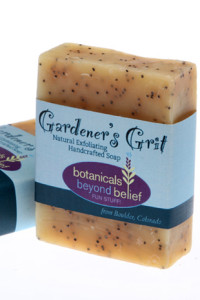Protect Yourself from Nature
Gardening Self Care
by Sandy Swegel
Being in the garden is lots of fun…the time with nature, the growing, even the weeding are all a joy to the gardener. Less fun is how dirty we get and how irritating nature can be to our bodies, especially in the form of excess sun and pollen. Here are some good old-fashioned tips to protect yourself from nature that will allow you to enjoy the time in the garden and still be able to be seen in polite company without dirt-encrusted nails and wheezing from allergies.
good old-fashioned tips to protect yourself from nature that will allow you to enjoy the time in the garden and still be able to be seen in polite company without dirt-encrusted nails and wheezing from allergies.
Protect your skin
with sunscreen of course.
Protect your fingernails.
I’ve found the Gardeners Grit Soaps are a nice treat after gardening, helping to remove the dirt that seems to work its way right into my skin. But the best part of a bar of soap is to run your fingernails over it before you go in the garden. Soap under your nails (or in cracked skin) blocks the dirt from settling in and your hands are much easier to clean later.
Protect your nose.
Pollen is one of the most annoying aspects of spring. Gardening is a lot less fun if you’re sneezing and wheezing. A trick I learned from a holistic doctor is to put a dab of petroleum jelly just inside your nostrils. The jelly catches lots of pollen and keeps it from being inhaled and getting into your nostrils and sinuses.
Protect your lungs.
Wear a face mask if you’re stirring up dust or pollen. There are three times I am sure to wear a dust mask even if it looks funny.
- 1. Cutting the grass. I don’t want to breathe in those weed seed heads that get blown around by the mower.
- 2. Cleaning up old leaves and debris. Molds and fungi get in old leaves that have been sitting around all winter. This is good for making leaf mold. Not so good in your nose and lungs.
- Spreading mulch. Mulches, especially wood mulches are full of dust and fungus. When you’re doing something aerobic like spreading mulch, you often breathe with your mouth open and you’re just sucking the dust right into your lungs.
Protect your house.
You know to take off your muddy shoes so you don’t track dirt all over the house. You need to be equally careful not to track pollen in. The mud you’ve accumulated is visible, but pollen has also coated you and lodged in your hair and clothes. When you’re finished gardening, go directly to the shower and put your dirty clothes immediately into the laundry. If you’re bothered by allergies, be sure to wash your hair. Pollen in your hair and clothing is just waiting to fall on your pillow and bed where you can breathe it in all night.
Protect your immune system.
I just learned this tip this week. Dehydration is the most important thing to protect your body from, especially if you have allergies. A Danish medical study showed that dehydration greatly increases your bodies allergic response to pollen and to events like wasp stings. Drink water before you go outside, while you’re working, and when you get back in. HYDRATE.
Nature is beautiful and inspiring, but also a bit wild and dangerous. Be prepared.

